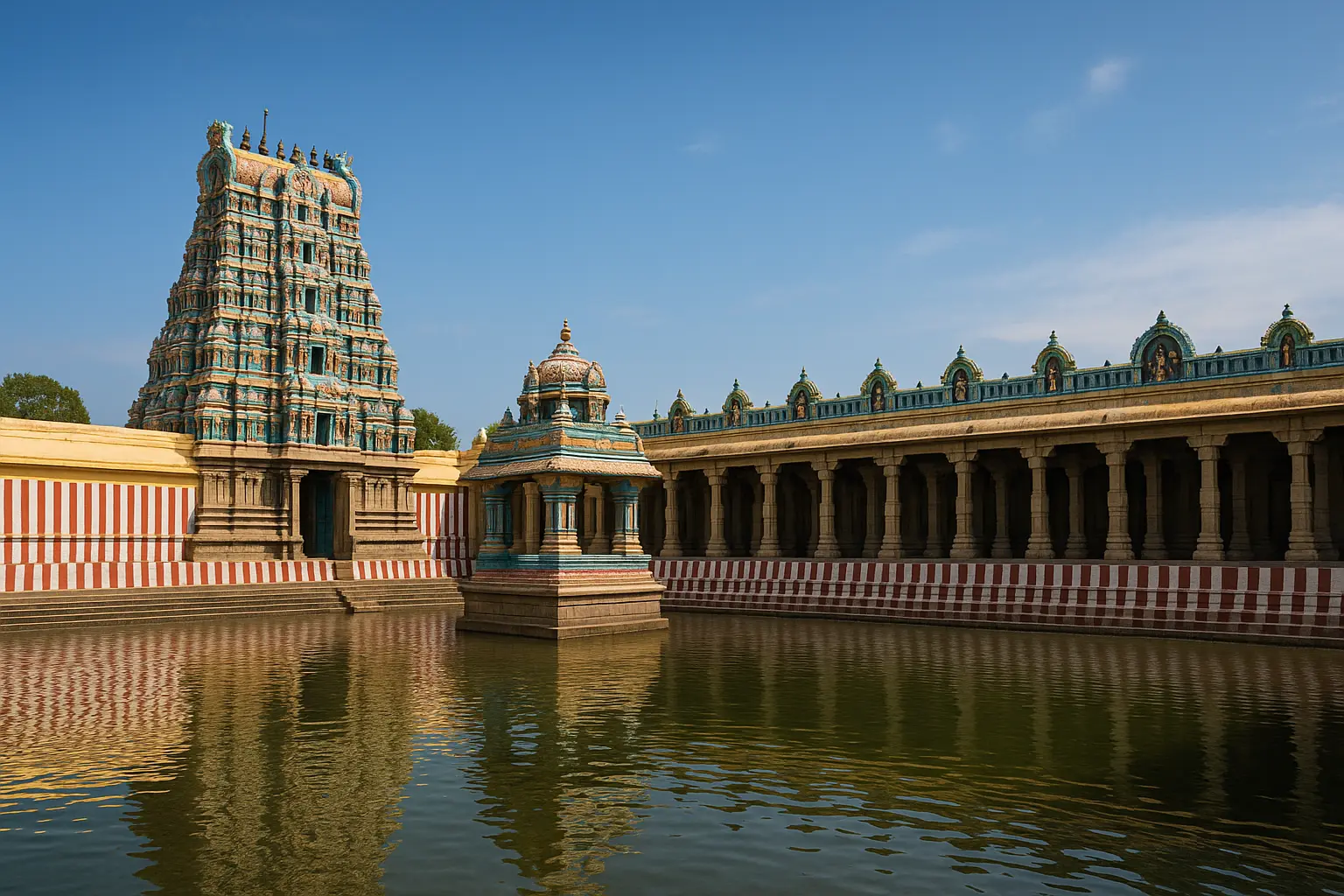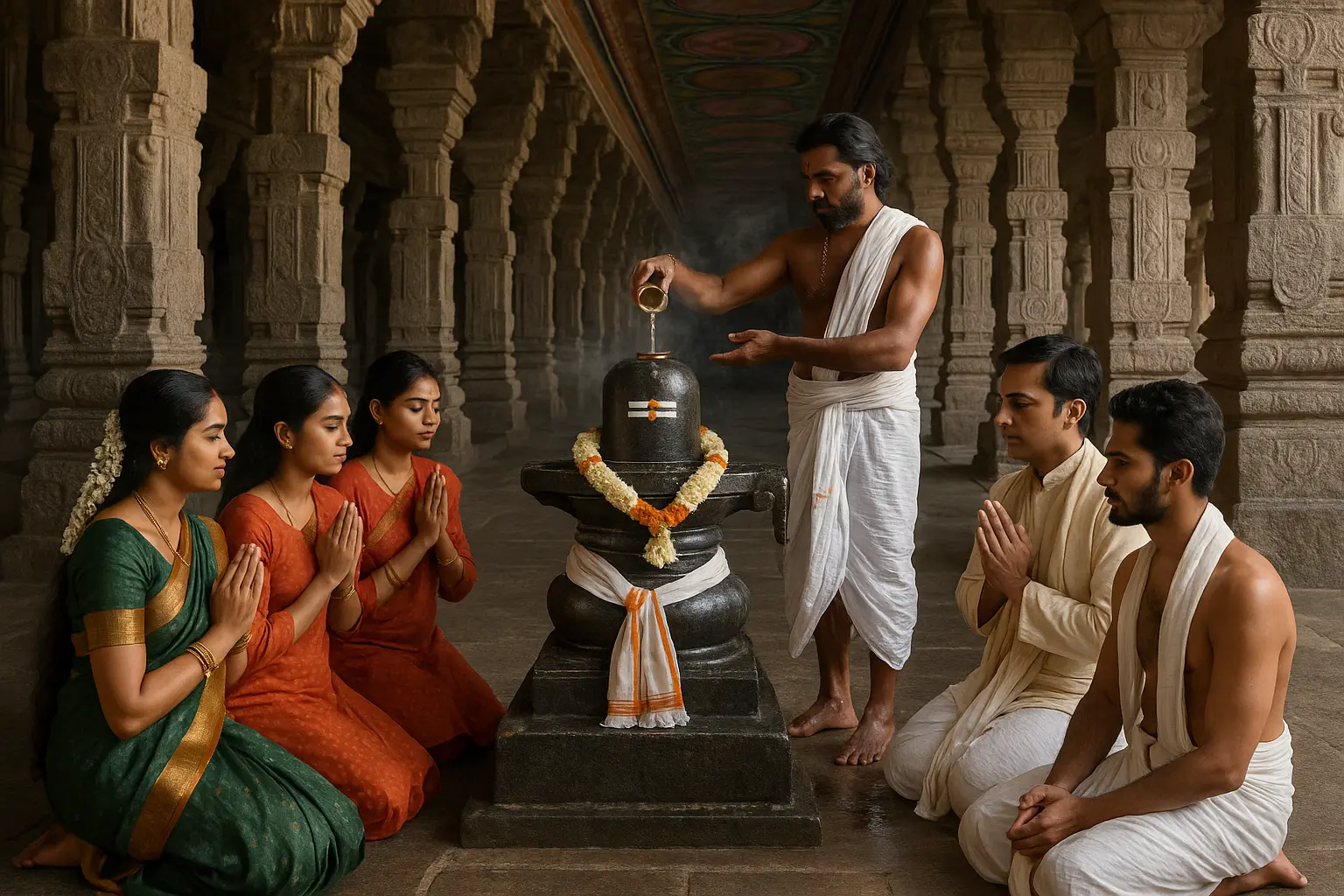Introduction
Located on the peaceful island of Rameswaram in Tamil Nadu, the Sri Arulmigu Ramanathaswamy Temple is one of the twelve crucial Jyotirlingas dedicated to Lord Shiva. Known for its grand corridors and sacred theerthams (holy water tanks), this temple is not only an example of South Indian architecture; it is also a spiritual foundation for millions of devotees.
Whether you are a Shaivite, Vaishnavite, or a Char Dham pilgrim, Rameswaram has profound religious meaning. It is believed that Lord Rama worshipped Shiva here before crossing to Lanka, making it an important meeting point for Shaiva and Vaishnava traditions.
Therefore, keeping purity, humility, and respect through your clothing is not just a guideline; it is an offering itself. The temple’s sacred atmosphere encourages devotees to dress thoughtfully and with cultural sensitivity.
Planning a visit to one of India’s holiest Shiva temples? Here’s what to wear and what to avoid to make your spiritual experience truly rewarding.
Why Dress Code Matters at Ramanathaswamy Temple
Sri Arulmigu Ramanathaswamy Temple is not just a historical site. It is a living centre of devotion that has kept its spiritual traditions for centuries. As one of the twelve sacred Jyotirlingas, the temple radiates divine purity and discipline. Your attire plays an essential role in maintaining that sanctity.
Wearing appropriate clothing shows respect for the ancient temple and Tamil customs and for the thousands of pilgrims who visit Rameswaram daily in quiet reverence. A modest dress code encourages cultural harmony, allowing people from different regions and backgrounds to feel united by devotion instead of being distracted by appearance.

In addition to respect, the dress code has a practical purpose. It helps reduce distractions and promotes mental focus during rituals, darshan, and meditation. Whether you are taking part in an abhishekam or simply walking through the temple’s famous corridors, traditional clothing connects you with the spiritual energy of the space.
Recommended Dress Code Guidelines
When you visit the sacred grounds of Sri Arulmigu Ramanathaswamy Temple, your clothing should show simplicity, humility, and respect. The temple has a strong tradition of modest attire based on Tamil spiritual customs that preserve the sanctity of the space.
For Men:
Men should wear a veshti (dhoti) along with an angavastram or a simple cotton kurta-pajama. This traditional clothing is culturally appropriate and comfortable in the temple’s warm, coastal climate. If a veshti is not possible, full-length cotton pants with a plain shirt (preferably with sleeves) are acceptable. Avoid wearing graphic or logo-heavy T-shirts.
For Women:
Women should choose sarees, salwar-kameez, or long skirts with a full-length top and dupatta. Wearing a scarf or dupatta to cover the head while entering the sanctum is a sign of respect and is highly encouraged.
General Tips:
- Stick to light, breathable fabrics—especially important due to the region’s heat and humidity.
- Avoid flashy colours, tight-fitting outfits, or party wear that may appear disrespectful in the temple environment.
- Make sure your clothing is clean, comfortable, and conservative to ensure a smooth and spiritually uplifting visit.
Dressing in traditional attire helps you blend into the rhythm of devotion that echoes throughout Rameswaram’s sacred corridors.
What Not to Wear
When visiting Sri Arulmigu Ramanathaswamy Temple, your clothing should reflect the sacredness of the temple and its long-standing traditions. The temple staff and local worshippers strongly discourage attire that disrupts the spiritual environment or seems culturally disrespectful.
Avoid wearing Western outfits like jeans, shorts, miniskirts, leggings, sleeveless tops, and crop tops. These items, while typical in casual settings, are not suitable for a revered temple like this one. Tight-fitting, transparent, or revealing clothes are also not appropriate because they may distract others and are viewed as disrespectful in a space meant for meditation and prayer. Similarly, T-shirts with bold graphics, slogans, or offensive messages should stay at home.
It’s also best to avoid leather items, such as belts, wallets, and jackets, since products made from animals are often seen as impure in many Hindu temples.
The guiding principle is straightforward: modesty and mindfulness. When you dress respectfully, you honour the presence of Lord Shiva and the sanctity of the temple.
Dress Code for Rituals & Special Events
Festivals and rituals at Sri Arulmigu Ramanathaswamy Temple are deeply spiritual events. It is essential to follow traditional dress codes. During significant occasions like Mahashivratri, Thai Amavasai, Navratri, or full moon rituals, the temple attracts many devotees. A higher standard of cultural decorum is naturally expected.
Suppose you are taking part in special abhishekams or planning to have a darshan of the Spatika Linga. In that case, it is important to wear pure and traditional attire. Many devotees choose freshly washed clothes or change after performing Agni Theertham snan, which is a ritual sea bath. Entering the sanctum in wet or casual garments is not allowed.

Look to the temple priests, who wear unstitched veshti and angavastram. This practice shows humility and purity. Similarly, pilgrims are encouraged to wear sarees, salwar-kameez, veshti, or kurta-pajama without flashy designs.
These sacred rituals are not just actions on the outside; they are a form of inner discipline. Dressing appropriately strengthens your connection to the divine energy present during these powerful ceremonies.
Seasonal Dressing Guide
Rameswaram’s coastal climate has high humidity all year round. Dressing appropriately for the weather helps ensure comfort and spiritual focus during your visit to Sri Arulmigu Ramanathaswamy Temple. Here’s a quick seasonal guide:
| Season | What to Wear |
| Summer (April–June) | Light cotton veshtis, sarees, or salwar-kameez. Keep a scarf or angavastram to cover your head during darshan. Choose breathable, sweat-absorbent fabrics. |
| Monsoon (July–September) | Go for quick-dry traditional clothing and simple sandals (easy to remove), and carry a compact umbrella or raincoat. Avoid heavy or elaborate outfits that can get soggy. |
| Winter (October–February) | Though winters are mild, early mornings can feel cool, especially during morning aarti—layer light woollen shawls over your saree or kurta for comfort. |
You can best experience Rameswaram’s sacred energy when you are not distracted by discomfort. Whether you are attending rituals or just soaking in the temple’s spiritual atmosphere, dressing with the climate and customs in mind helps create a peaceful darshan.
Where to Buy or Rent Temple-Appropriate Clothes
Finding traditional attire near Sri Arulmigu Ramanathaswamy Temple is both easy and affordable. Just outside the East and West Gopuram gates, you’ll find several small clothing shops and stalls catering specifically to pilgrims.
You can purchase veshtis, angavastrams, sarees, and salwar-kameez sets made of light cotton, perfect for the coastal weather of Rameswaram. For those who prefer not to buy, rental counters offer clean, ready-to-wear veshti and angavastram sets for a nominal fee, typically ranging from ₹50 to ₹150.
Many vendors also provide combo kits that include basic puja essentials along with traditional clothing, especially useful for devotees participating in Abhishekam rituals or sea baths at Agni Theertham.
Tip: These shops usually open early in the morning to accommodate pilgrims heading for sunrise darshan or special poojas.
Dress Code Guidelines for Foreign Devotees
Finding traditional attire near Sri Arulmigu Ramanathaswamy Temple is easy and affordable. Just outside the East and West Gopuram gates, you will find several small clothing shops and stalls that cater specifically to pilgrims.
You can buy veshtis, angavastrams, sarees, and salwar-kameez sets made of light cotton, which are perfect for the coastal weather of Rameswaram. If you prefer not to buy, rental counters offer clean, ready-to-wear veshti and angavastram sets for a small fee, usually between ₹50 and ₹150.
Many vendors also provide combo kits that include basic puja essentials along with traditional clothing. This is especially useful for devotees participating in Abhishekam rituals or sea baths at Agni Theertham.
Tip: These shops generally open early in the morning to accommodate pilgrims going for sunrise darshan or special poojas.
Do’s & Don’ts: Dress Code Checklist
Before stepping into the divine corridors of the Ramanathaswamy Temple, it’s important to check your attire. Here’s a quick reference table to help you dress respectfully and appropriately:
| ✅ Do’s | ❌ Don’ts |
| Wear traditional clothes like veshti, saree, or salwar-kameez | Don’t wear jeans, skirts, shorts, sleeveless, or tight-fitting tops |
| Cover your head and shoulders, especially near the sanctum | Avoid leather belts, wallets, jackets, and flashy or printed clothing |
| Use breathable, clean cotton fabrics suitable for the coastal climate | Don’t enter the temple immediately after a sea bath while still wet |
| Change into dry, fresh clothes after Agni Theertham snan. | Avoid partywear or casual tourist-style outfits |
Dressing appropriately is a sign of bhakti (devotion), not formality. Let your clothes reflect the sanctity of the space you’re entering.
Conclusion
Dressing appropriately for your visit to Sri Arulmigu Ramanathaswamy Temple is about embracing devotion and respect. The temple has a long history and invites you to connect with the divine through humble thoughts, actions, and clothing.
Wearing simple, modest, and respectful clothes honours the customs of this sacred Jyotirlinga and improves your own spiritual experience. Each step you take inside the temple is a journey through history, faith, and holiness.

